SUPPORTING FAMILIES THROUGH CHILDHOOD CANCER
Empowerment
What research is happening to empower children, young people and families during and after treatment? What resources are being designed?
PHYSICAL ACTIVITY PATHWAYS
ACCESSIBLE INFORMATION
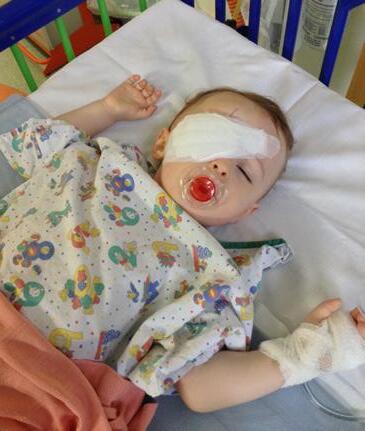
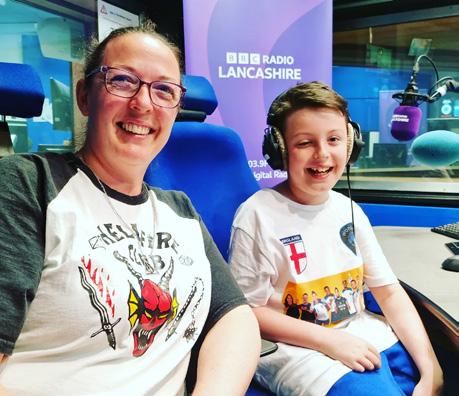
A parent's view
Nicky Levent, mum to Sam, who was diagnosed with retinoblastoma at 18 months old, explains what it means to her family to raise awareness of childhood cancer Page 15
BACK TO BASICS:
Donating cancer samples for research
What happens when you donate cancer samples for research? Page 8
APPRECIATING THE SMALL THINGS AND EMBRACING OPPORTUNITIES
Sarah Dransfield, who was diagnosed with bone cancer aged 16, explains what helped her during and after treatment and how having cancer changed her outlook on life Page 6
Page 12
Page 6
INSIDE THIS ISSUE...
ON RELATIONSHIPS
05 Raysa Farah, whose son, S'aad, was diagnosed with leukaemia aged two, explains how her and S'aad's experiences during his treatment inspired her to write a children's book
10 Teifi Rowley, who underwent cancer treatment twice as a child, tells us about a character they created that helped them process the long-term impact of treatment
11 Louise Graham, a physiotherapist, tells us about a physical activity pathway she designed to help children and young people stay active during treatment
14 Dr Claudia Heggie tells us about research she's been leading into understanding the use of a light treatment to prevent a side effect of chemotherapy called mucositis
16 Dr Shaarna Shanmugavadivel tells us about her team's work which aims to raise awareness of childhood cancer symptoms among healthcare professionals and the public alike
EVERY ISSUE
04 Medical adviser
Dr Ren Manias introduces the theme of ‘Empowerment'
04 News in brief
A round-up of the latest updates in childhood cancer
08 Back to basics
Professor Deb Tweddle and Dr Mariya Geneshka, of the VIVO Biobank, tell us more about the facility, the process of biobanking, and its importance to research
17 Getting the ending right: feeling prepared to move into survivorship care when active treatment finishes
A research project funded by CCLG
18 60 seconds with...
Emily Baker, a clinical research nurse and CCLG member, tells us about her role
19 Ask the expert
Naomi Shefford-Thomas, CCLG's Health Information Officer, explains what accessible information is
ON THE COVER
06 Sarah Dransfield, who was diagnosed with bone cancer aged 16, explains what helped her during and after treatment and how having cancer changed her outlook on life
12 Helen Pearson, a nurse and researcher, tells us about an important new web resource to support families' decision making for relapsed and refractory neuroblastoma
15 A parent's view
Nicky Levent, whose son, Sam, was diagnosed with retinoblastoma at 18 months old, explains what it means to her family to raise funds for charities and awareness of childhood cancer
Contact
is a free, quarterly magazine for families of children and young people with cancer.
Contact aims to reduce the sense of isolation many families feel following a diagnosis of childhood cancer. Children’s Cancer and Leukaemia Group brings together childhood cancer professionals to ensure all children receive the best possible treatment and care. Contact magazine was founded by The Lisa Thaxter Trust and CCLG and first published in 1999. The contents of Contact are the copyright of the publishers. Articles may be reprinted without charge provided that credit is given to Contact magazine. A copy of any reprinted article should be sent to the editor at the address above. Please let us know your thoughts and feedback about Contact by emailing our Editor at editor@cclg.org.uk
Editorial Team and Board:
Managing Editor – Ashley Ball-Gamble
Editor – Claire Shinfield
Assistant Editor – Sam Chambers
Graphic Designer – Georgina Payne
Medical Adviser – Prof Bob Phillips
Medical Adviser – Dr Ren Manias
Ceri Hogg – Nurse, Cardiff
Mike Francis – Parent and Survivor, York
Katherine Ince – Survivor, London
Dr Vikki Langford – Psychologist, Birmingham
Dr Rebecca Mulholland – Psychologist, Sheffield
Rachael Olley – Parent, CCPA
Gayle Routledge – Parent, Stafford
Samantha Schoolar – Survivor, Coventry Gill Thaxter – Parent, Coulsdon
Nicky Webb – Nurse, East Midlands
Past issues of Contact: The wide variety of articles published during the year in Contact adds up to a valuable and informative reference archive. If you would like any back issues, please contact the Editor. Details of key articles in previous editions are listed on our website.
Editor: Claire Shinfield
editor@cclg.org.uk
facebook.com/cclguk

instagram.com/cclguk
@cclguk
Hello! Your messages...
Praise for Contact’s recent editions on ‘Relationships' and 'Education’...
“A really great edition. Really enjoyed reading the raft of informative and encouraging articles that will resonate with many.”




“So informative.”
CCLG’s information resources offer wide breadth of support
“The publications from CCLG are brilliant! There's a guide for everyone about almost anything you're likely to encounter on a childhood cancer journey. When a child is diagnosed with cancer, the whole network around that child is impacted. Support is available for everyone, not just the child.”
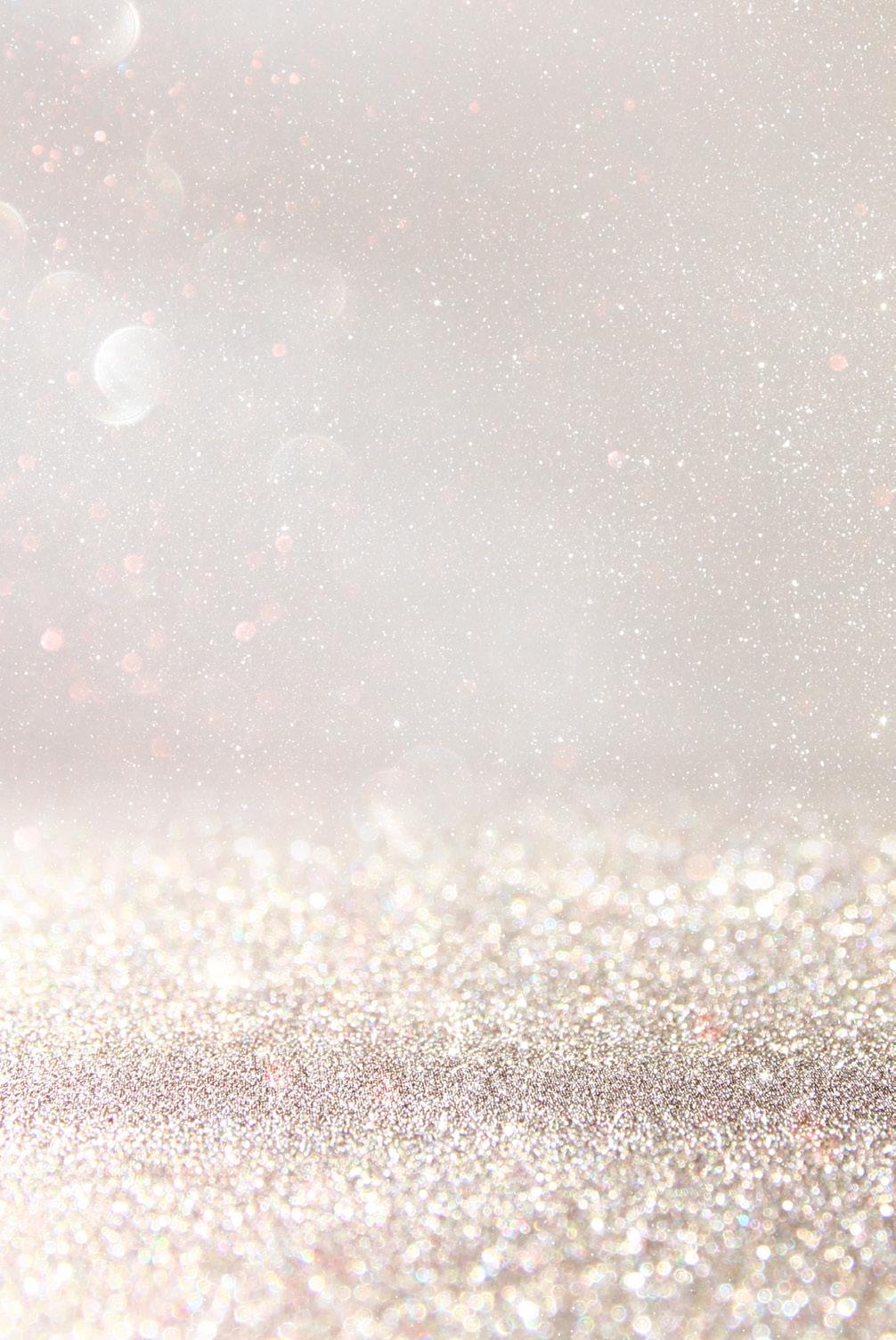
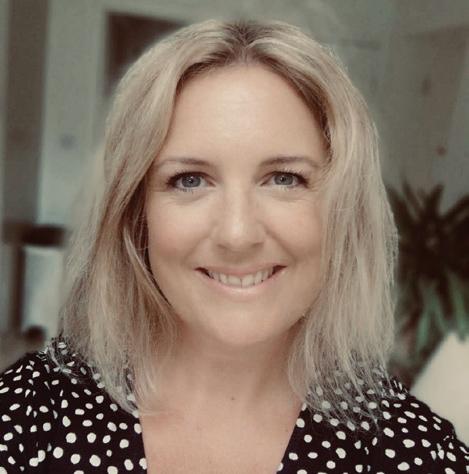
We may not be able to control what is happening to us, but we can try and lessen the impact. When life feels hard, we can empower ourselves through action to do something about it. This issue showcases many examples of how patients and families have empowered themselves to help them face the challenges of cancer. We also learn more about how CCLG's expert members are working hard to help families feel more empowered when making decisions about their child's treatment and care. Our Child Cancer Smart project aims to help healthcare professionals and the public alike recognise the signs and symptoms of cancer in children and young people to prevent referral delays. We hope this issue gives confidence and inspiration to others who are facing the same cancer journey.
If you would like to SHARE YOUR STORY in Contact or have an idea for a theme for us to cover, please let us know. Email us at editor@cclg.org.uk
Give your mind and body a boost by joining our...

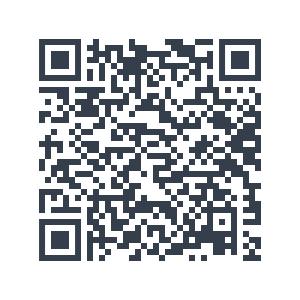

Challenge yourself in January and February by walking 100 miles to help fund vital research into childhood cancers.
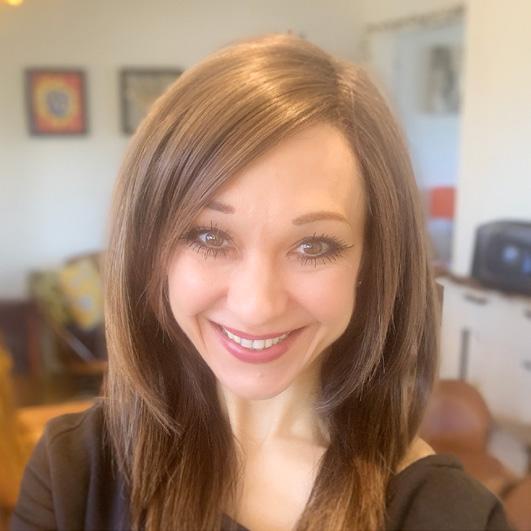
MEDICAL ADVISER
Dr Ren Manias
Consultant Paediatric Oncologist at Southampton General Hospital and CCLG member
A childhood cancer diagnosis is devastating, and parents can often feel overwhelmed, helpless, and unsure about how to advocate for their child’s needs in a complex medical system. Empowering parents can significantly improve their ability to cope, make informed decisions, and provide emotional and practical support for their child. Education is one way to empower parents. Cancer is complex, with various treatment protocols, side effects and long-term implications. Providing parents with clear, accessible information about treatment options and potential outcomes is vital. Knowledge gives parents the confidence to ask informed questions, participate actively in decision making, and better understand the medical jargon that doctors may use, which can help them feel more in control.
Fostering strong communication between parents and healthcare providers is also essential. Parents should feel comfortable discussing concerns, asking questions and expressing preferences regarding their child’s care. They should feel like partners, with their input valued and respected, rather than passive recipients of information. Support networks are also key. Whether through formal support groups, online communities, or informal networks of family and friends, connecting with others who have experienced similar challenges can provide emotional and practical support. These networks often offer encouragement, shared experiences and coping strategies. Support groups can also provide parents with advocacy tools and access to additional resources and help with practicalities like navigating insurance issues and school systems.
Parents of children with cancer often face intense emotional stress and helping them build resilience is key to navigating this journey. Strategies might include psychology support, counselling, stress management techniques, and encouraging self-care. Parents who are emotionally resilient are better equipped to care for their child, advocate for their needs, and maintain a sense of hope. By supporting and facilitating all of this, we can help parents to feel empowered to face the journey ahead, ensuring they provide the best possible support for their child.
NEWS IN BRIEF
Potential new treatment for rare childhood brain tumour
A potential drug could target a rare and aggressive brain tumour called diffuse hemispheric glioma H3G34mutant. Research found a weakness in these tumour cells and used a drug used to treat breast cancer, called ribociclib, to slow their growth. It was able to significantly extend the life of a child diagnosed with diffuse hemispheric glioma. While early results are promising, more tests and clinical trials are needed.
(Source: The Brain Tumour Charity)
Scientists identify genetic predictors of relapse in childhood leukaemia
US researchers have found new genetics-based means to predict relapse in standard-risk B-cell acute lymphoblastic leukaemia (B-ALL). They sequenced the genetics of B-ALL samples, and also analysed which genes were active. They found some B-ALL subtypes had a low frequency of relapse, but others were associated with an increased risk. This could be identified by certain genetic alterations and chromosome differences, meaning children could be tested for risk, with treatment altered accordingly.
(Source: Health Tech World)
Whole lung irradiation linked to better metastatic rhabdomyosarcoma outcomes
US researchers have uncovered a difference in survival rates for children with rhabdomyosarcoma that has spread to the lungs who have had whole lung irradiation (WLI) as part of their treatment. Comparing over 100 patients who did or didn’t have WLI as part of their treatment, they found that patients who’d received it were over 13% more likely to survive five years or more. They hope their findings highlight the importance of WLI for certain patients and advise improving guidelines around it.
(Source: Journal of Clinical Oncology)
New technology allows for greater knowledge-sharing
A new artificial intelligence (AI) programme has been shown to help identify and assess childhood brain tumours from MRI scans. Tested across 19 hospitals worldwide, it uses a method called ‘federated learning’ which doesn't involve sharing sensitive data between hospitals. Unlike traditional AI, which usually needs vast amounts of shared data and can raise concerns for patients' privacy, this programme keeps data secure. The accuracy of the programme's diagnosis and classification was similar to standard AI, suggesting it could help foster collaboration and data security.
(Source: Nature.com)
“Writing gave me something to focus on”
Raysa Farah’s son, S’aad, was diagnosed with leukaemia aged two. Here, she explains how her and S’aad’s experiences during his treatment inspired her to write a children’s book, empowering both her and other young children with cancer.
S’aad was diagnosed with acute lymphoblastic leukaemia with few warning signs. There was some tiredness, and he was pale in colour, but the limping became a cause of concern, which made us contact 111. From then on, tests were done after persistently asking for further investigation.
After his diagnosis, S’aad began 12 weeks of intense treatment, and thereafter had oral chemo daily and weekly visits to the hospital for various medications and interventions. While in hospital with him for those first few months, I was eager to make a positive difference through such a challenging time, so I had an idea to write a children’s book.
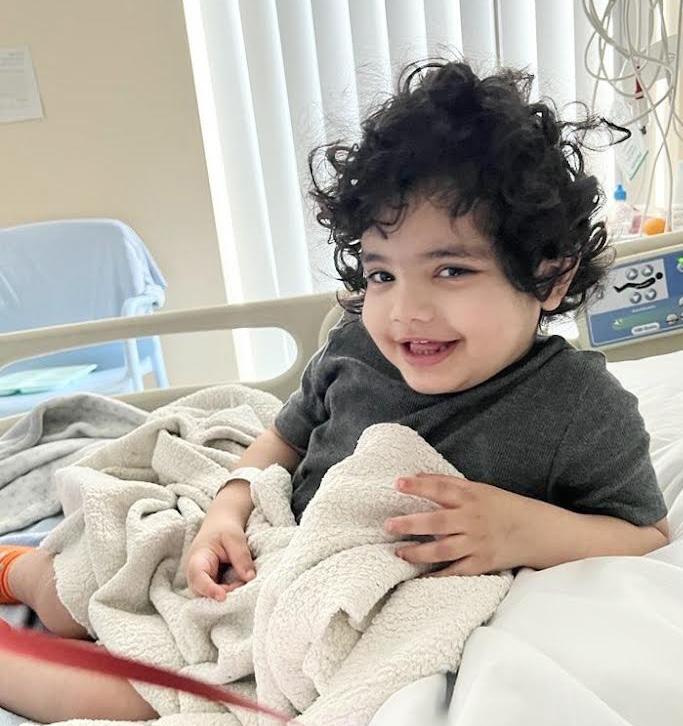
I just started writing whilst he was sleeping and thought, "I actually enjoy this." When I was figuring out which direction to take the book, I realised S’aad had really big, wild, curly hair. Everyone knew him because of his hair and would stop us to say his hair was gorgeous. It was his prized possession, but he’d lost it through chemo treatment. So, I wanted to teach young children that despite physical differences, you can have a voice, or a roar, just as loud as your friends and that each child is still so special. This is why
the book’s premise follows a lion cub who loses his big, wild mane after developing leukaemia, but shows bravery to continue being himself and not let his illness get him down.
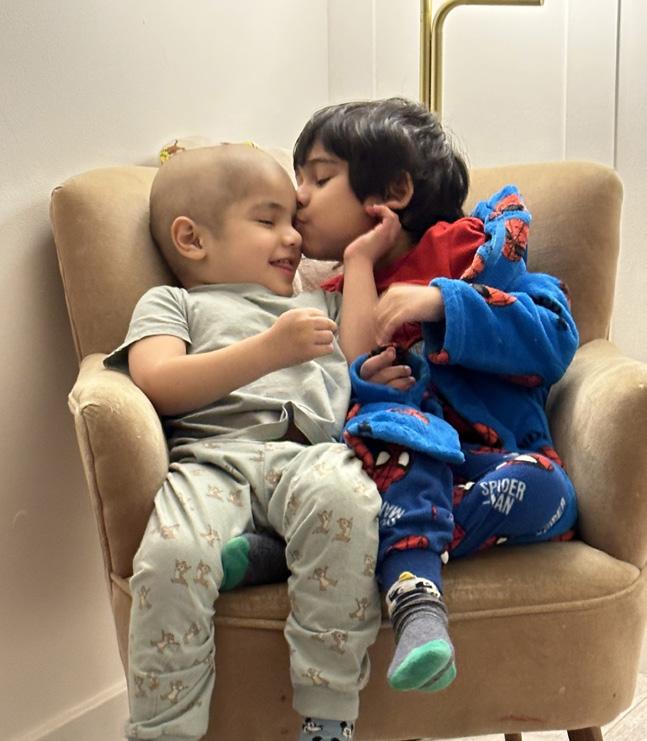
S’aad’s brother, Adam, who was four at the time, was asking, "What’s going on?" and "Why has he lost his hair?" I was trying to explain to him and initially he was quite surprised because it all came off in one very short period. Trying to explain to a four-year-old what was going on, it made me think there must be a lot of parents out there who are feeling the same as what I was feeling. I wanted to help them, and their children, too.
I never imagined myself writing a children’s book. But having been hit by our child having cancer and through the long days at hospital, it gave me something to focus on. And, at a time when you’re going through something like that, having something to focus on is really important.
S’aad would sleep a lot after his treatments and it gave me a purpose. It allowed me to feel like I was doing something positive and constructive through a challenging time and to hopefully make my boys proud one day
of how, as a mother, I handled such a hard time in our lives.
While the book is about my own and my son’s experiences, I also wanted it to empower children to be themselves and not let other people dictate their image. I think in a society where children have that pressure, I wanted this book to really empower young children to feel that they’ve got a voice in the world and they’re special, even if they look different. Not only through illness, they might just look different. I hope this book makes them feel like they can still be them and empower them to embrace who they are.
S’aad is now five and is doing great. He’s in reception at school and is thriving emotionally and socially and is completely and utterly obsessed with dinosaurs. If I could offer any advice to other families, it’s to take one day at a time, and there’s no right or wrong way to handle this journey that you’re on.
‘The Cub Without a Mane’ is available to buy on Amazon either as an e-book or physical copy.
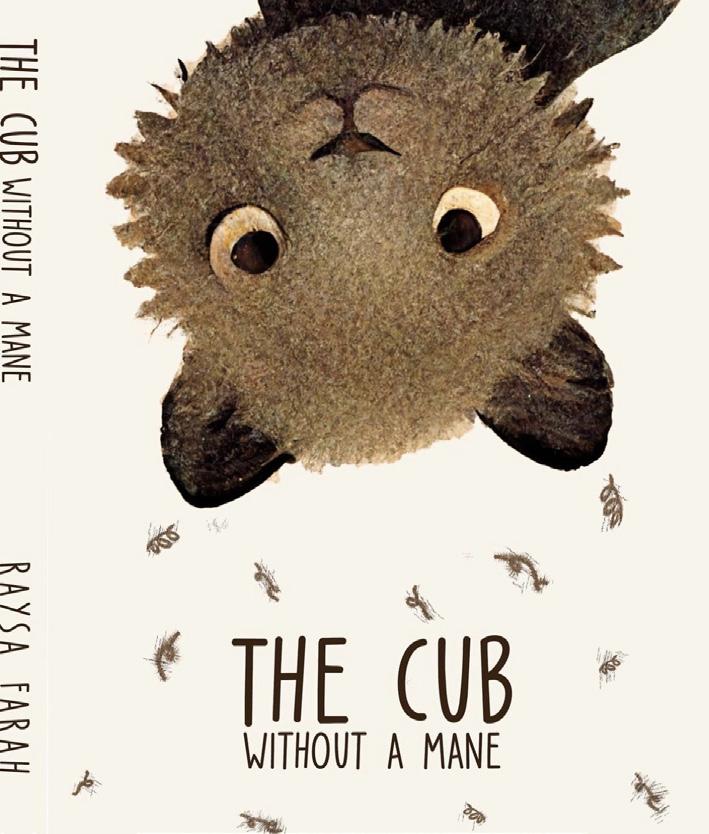
Appreciating the small things and embracing every opportunity
Sarah Dransfield was diagnosed with bone cancer in March 2012 aged 16. Here, she tells us what helped her during and after treatment and how cancer has changed her outlook on life.
I was just 16 years old when, to save my life, I had my right leg amputated above the knee due to osteosarcoma. Before my diagnosis, I’d been getting pain in my knee which increasingly worsened for about three months. My grandma said that I should go to the doctors, which I’d never thought about as I thought the pain would just go away by itself. The doctor felt my knee and said he thought it was a sprain and told me to keep taking painkillers. So, that’s what I did. A few weeks passed, and it had got to the point where the painkillers weren’t doing anything.
Coincidentally, my brother was seeing a physio for a sports injury at the time, so Mum took me along. At the end of his appointment, she asked if the physio could have a quick look. He knew straight away that something wasn’t right and booked me in for an appointment. I saw him a few times over the next few weeks. He first thought a growth spurt
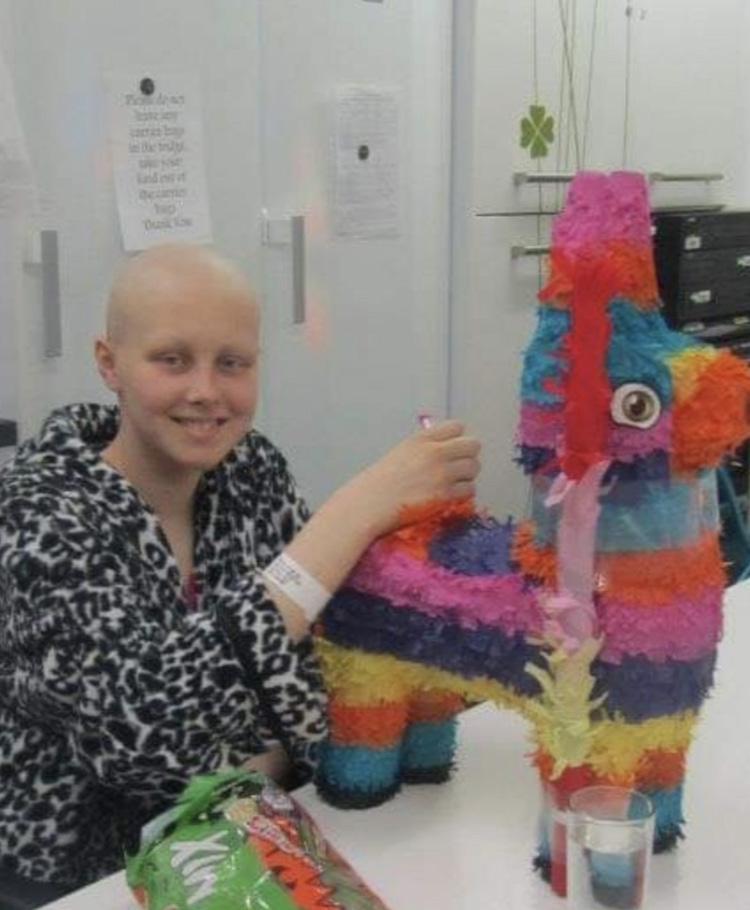
had meant my knee had turned inwards, so I started wearing insoles. But one particular evening he sat me down and felt my knee, which was warm. He looked shocked, like something had clicked in his mind. He told Mum that I needed a private MRI scan, and luckily, he had contacts that got me booked in the next day.
"My family and friends helped me so much. They wanted to do as much as they could to give me fun and enjoyment along the way. Having things to look forward to and setting a bucket list for when I finished my treatment really helped me."
Halfway through the scan, I was taken out of the machine. I was sat back in the waiting room, before being asked if I’d ever had surgery on my knee, which I hadn’t. The following day, on her birthday, Mum took a call which would change our lives for ever. Not only were we told I had cancer, but I’d also lose a year out of my life and might need my leg amputated. It was all too much. I had so many questions, and that night I didn’t sleep a wink. I’ll remember it for as long as I live.
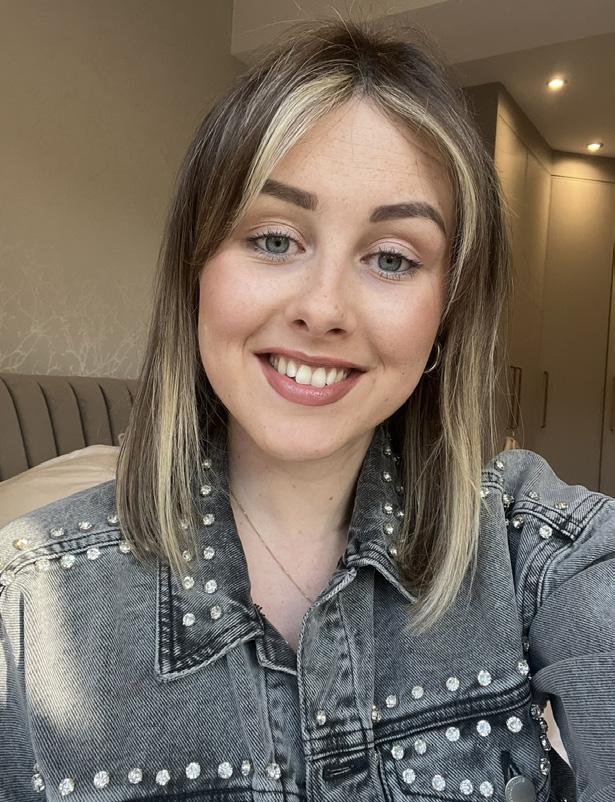
Everything moved so quickly
From then on, it was all a whirlwind. We were sent to Birmingham Orthopaedic Hospital a week later, where they took a biopsy from my leg. I was given crutches to use, and they told me I was going to receive some very strong chemotherapy in the coming weeks and lose my hair. Arriving in Leeds for my treatment, I was terrified. I’d seen young people on TV with cancer but that was never supposed to be me. The chemotherapy hit me harder than I ever thought was possible. I was losing my hair within a week, I was sick to the point where I couldn’t keep anything down, any slight smell turned my stomach, and I was tired and weak. As time went on, I was receiving regular blood transfusions, platelets, intravenous antibiotics and a feeding tube inserted up my nose. It was really tough, and I was counting down the weeks to the end of treatment.
What helped me during treatment
My family and friends helped me so much. They wanted to do as much as they could to give me fun and enjoyment along the way. Having things to look forward to and setting a bucket list for when I finished my treatment really helped me and allowed me to picture a life after it. We also had a youth support coordinator on our ward, who used to get me out of bed and into the day room for daily activities. At first, feeling shy, I didn’t want to join in. But once I did, it really changed my hospital experience. I was able to meet other young people and keep my mind occupied.
I had some very good nurses and doctors, like Dr Bob Phillips (Contact’s Medical Adviser), who always knew how to cheer me up and put a smile on my face! I received support from many charities, but one that stands out is Project Youth Cancer, which used to be known as The Laura Crane Youth Cancer Trust. I remember receiving a mountain of presents from them on Christmas day, which was very special. They also provided laptops for patients in hospital so that we could stay in touch with our friends at home, which meant we didn’t feel as isolated. I went on to volunteer for them before becoming an ambassador, and more recently, a trustee.
How I came to accept and embrace my amputation
About three months into treatment, I was told that I’d need my leg amputating, which I initially refused. I couldn’t imagine life with one leg. How could I? However, my specialist nurse and social worker helped me think again. I wanted to live, so I didn’t have a choice. I initially felt less poorly straight after surgery as the cancer that was taking all my energy had gone out of my body. I wouldn’t look at my leg, though. I couldn’t face it at first.
But, over time, my new body became more familiar. I was introduced to my first prosthetic leg and when I put it on, I felt like I had a full body again. It's been a long journey since then, full of ups and downs. I was on crutches for a long time, until I built up my confidence and finished treatment. I’ve found out over time that having a good fitting leg makes being an amputee a lot easier. When it’s not fitting, the sores and the pain can be unbearable. However, I’ve achieved and done so much thanks to having a prosthetic leg that I could no way have done without it!
I used to be really self-conscious about my prosthetic. At first, being so young and low in confidence, I even felt ashamed. But a couple of years later I went to an event called LimbPower, unsure of what to expect. There were around 200 other amputees there, and I was the only one covering my leg up. I had foam around it to make it look like a real leg and jeans to cover it. The event made me question what I was doing, and I realised I should be proud of what I’ve been through, and definitely not ashamed! From that day on, I learnt to embrace my disability and to champion it.
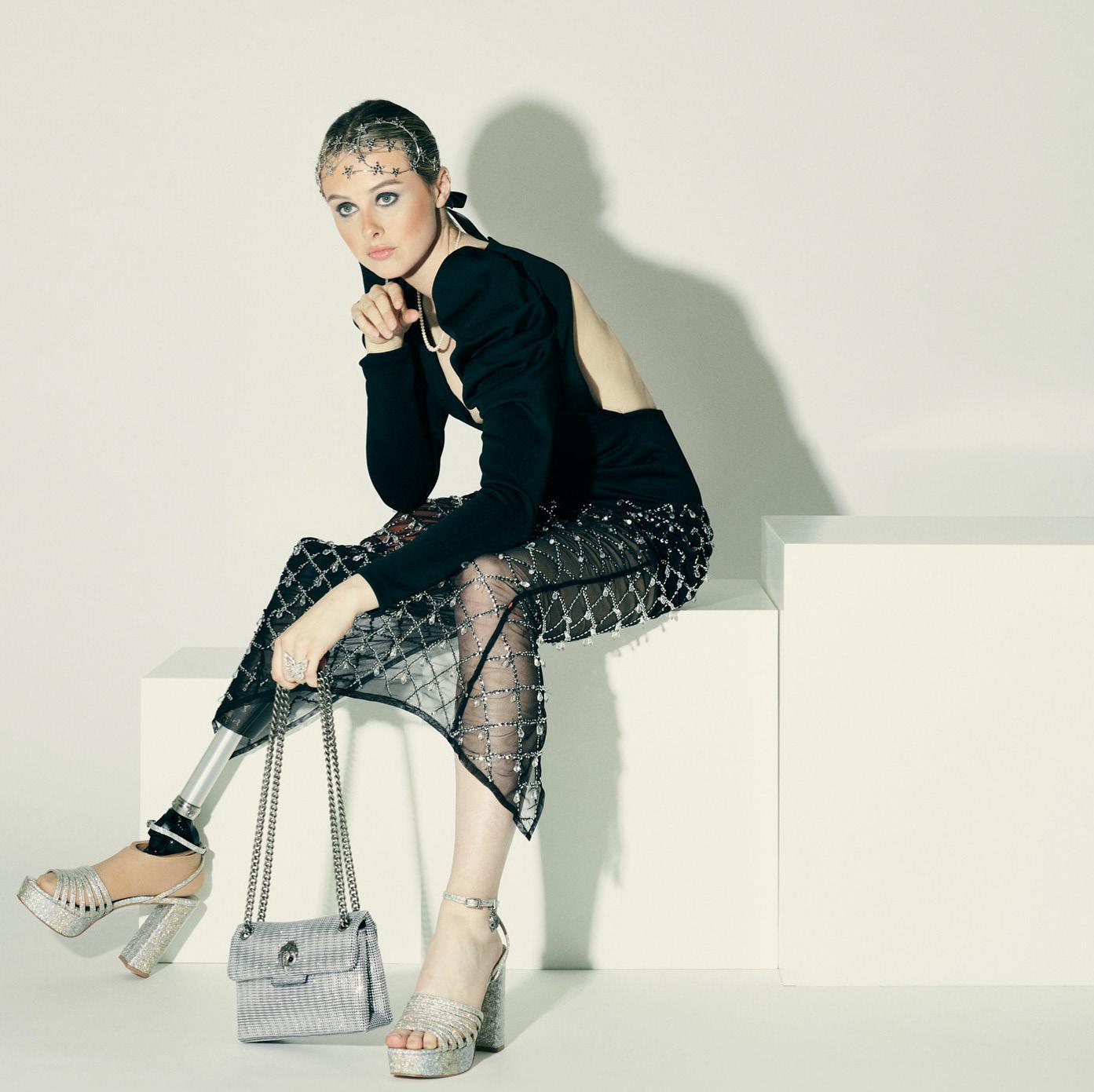
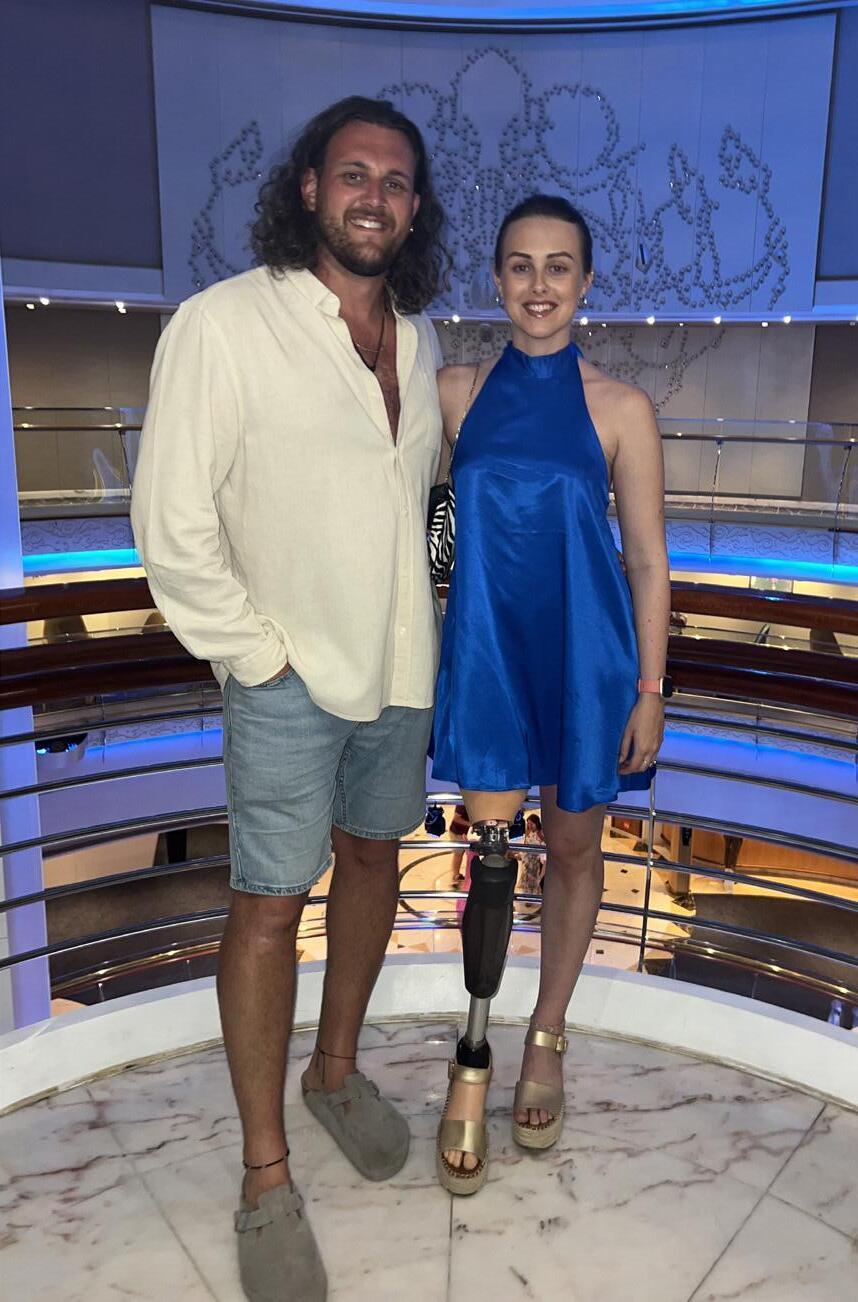
I’m proud of everything I’ve done
Since finishing treatment, I’ve done so many things that I’d never even imagined I’d ever do! I’ve modelled for River Island, Adidas, Amazon and Primark and I’ve even featured in Italian Vogue. I’ve featured on BBC's ‘Sewing Bee’ as a model, which I thoroughly enjoyed. I also met Phil, my boyfriend of seven years, on Channel 4’s ‘First Dates’. We then bought a campervan together and travelled Europe!
Being an ambassador for Project Youth Cancer means I’ve jumped from planes, taken part in charity bike rides and become confident in public speaking. I’ve spoken in front of numerous professionals, at universities, colleges, schools, charity and business events, which I’m very proud of. It’s something I’d never have done before treatment.
I feel richer in life for going through what I have. I’ve learnt to appreciate the small things and the finer details, as well as to cherish time with family and friends. I’m very grateful for every day and even though I've come out of the other side of treatment with a new disability, I feel so lucky to be alive, and want to make the most of it! I’m currently expecting my first child, and I didn't think that would be possible. Life, and our health, shouldn’t be taken for granted. We only get one shot at it, so I want to take every opportunity to enjoy every minute.
back to basics
Donating cancer samples for research
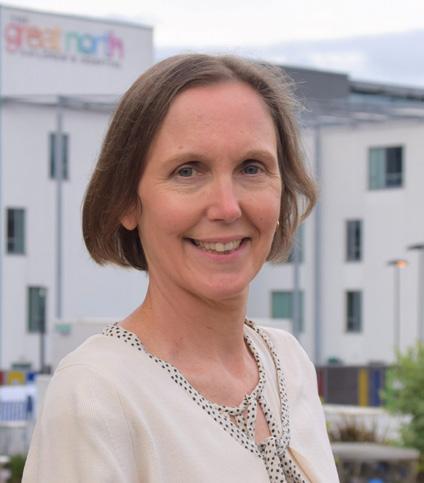
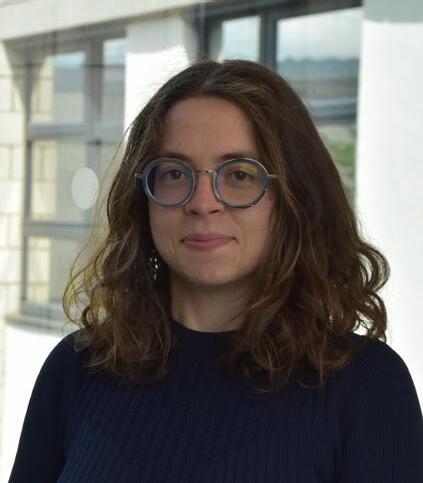
A biobank is a store for cancer samples which are then released for research studies. Professor Deb Tweddle, Director of VIVO Biobank, Professor of Paediatric Oncology and Honorary Consultant at Newcastle University and Newcastle Hospitals, and Dr Mariya Geneshka, Research Associate at the University of York, tell us more about donating samples for biobanking, and its importance to improving treatment and care.
Biobanking is the process of collecting, storing and processing biological samples for the purpose of research. A biobank is a secure facility that stores these samples. In the case of children’s and young people’s cancer, these may be pieces of tumours or leftover blood or bone marrow samples from hospital tests. Researchers can request these samples to help them learn more about the biology of children's and young people’s cancer, which is fundamental to understanding the causes of it, how to develop new treatments, and how, potentially in the future, to maybe even prevent it developing in the first place.
What is the VIVO Biobank?
It’s a new children’s and young people’s cancer biobank, funded by Cancer Research UK and Blood Cancer UK. It was formed from a merger of two very well-established biobanks: the CCLG Tissue Bank, which began in 1998, and the Leukaemia Cell Bank, which began in 2005. It was decided in 2021 for the two to join up, to improve practice for both banks in terms of accessing samples, storing samples, and regulation and governance, but also so that the medical staff that were asking patients and families for consent only needed to use one form for both solid tumour and leukaemia samples. Solid tumour samples are transferred from centres to the Newcastle University central biobank and liquid samples to the UK Biocentre in Milton Keynes.
Having a unified, single resource of cancer samples from children and young people allows better collaboration and dissemination of research. As a larger biobank, this allows us greater visibility in the research community, so more researchers can use the samples that we store. It allows for a much wider scope of research to be done, that could hopefully result in better outcomes in the future.
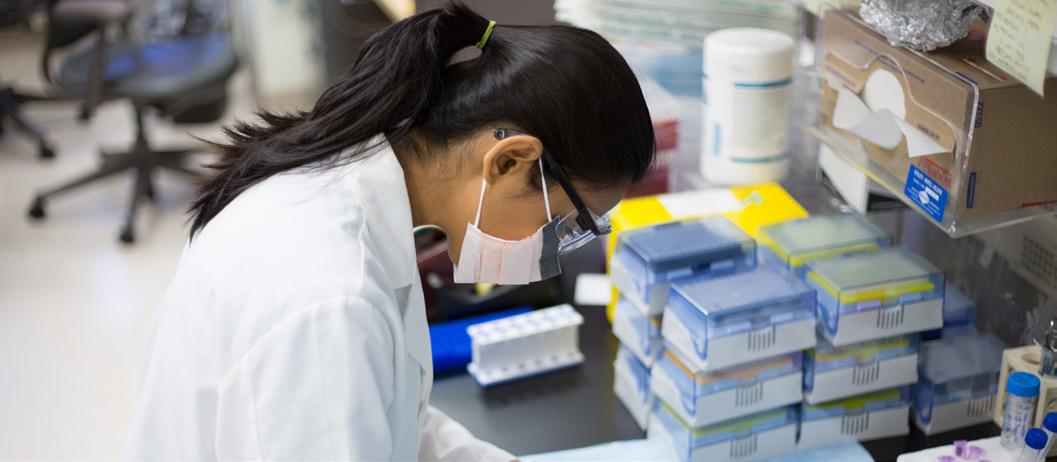
How has biobanking contributed to the progress in children’s and young people’s cancer research?
During the past 25 years, research from banked samples has ranged from developing new tests to diagnose cancers, new ways to measure treatment response or outcomes, and new ways of classifying the cancer risk group which then determines how a patient with that cancer is treated. This has all led to a better understanding of tumour biology, leading to the development of new treatments for children and young people’s cancer.
What do patients and families have to do to donate their samples?
It’s a really simple process. Patients and families are approached in their treatment centre and asked about donating a sample to the biobank. The initial approach for consent is almost always made by research nurses, though it can sometimes be the child's or young person's doctor. Patients/families are provided with detailed information sheets and consent forms, and usually given at least a couple of days to look at them, sometimes longer. Then, when they're ready, the research nurse will go through everything with them. After the consent forms are signed, we’ll register samples that have either already been taken, or take additional samples if it’s been agreed to them being taken for the purpose of research.
All children's cancer principal treatment centres are banking centres and we've now expanded into teenage and young adult centres as well. It’s been a real strength of our new merger that we've been able to do this.
What is ‘deferred consent’?
It’s something we sometimes do at the point of diagnosis, when it can be very overwhelming for families/patients, and difficult to process lots of information. So, we may take the samples at diagnosis but return for consent within a period of eight weeks. For example, if a patient's having a bone marrow sample, you only get one chance to take it, so the sample is taken, and then gets stored and flagged as awaiting consent. Then, there are eight weeks in which the research nurses or consultant can approach the family to ask if it’s okay to donate the sample. It almost always is, and the samples remain in the bank, but on the occasions consent isn't obtained for various reasons, then we would need to destroy those samples.
What if someone agrees and then changes their mind?
Samples are kept indefinitely and available for research, as long as we are a registered tissue bank, and we have a Human Tissue Authority license to store samples. However, you can ask us for the samples to be removed from the bank at any time, as long as they’ve not already been used for research. You can do this by contacting your treatment centre who’ll then notify the bank, and the samples will then be destroyed.
Can you only donate samples at diagnosis?
Most patients donate at the point of diagnosis, but not always. For example, if a patient's tumour relapses, they can donate that sample, even if they’ve not donated their first sample, though we’d probably ask them if they want to donate that as well, if it's still stored somewhere. Patients can choose to donate their samples, particularly from solid tumours, any time after diagnosis, so they don't have to choose to donate their sample immediately. We have samples come into the biobank from patients diagnosed years before, where maybe they weren't informed about the biobank at the time they were diagnosed, but later on, when they met with a consultant, they may have learned about it. There’s quite a lot of flexibility in when patients can donate their samples, and it's not necessarily tied to diagnosis.
What kind of samples are stored?
Mainly samples of tumour, blood, bone marrow, cerebrospinal fluid and urine are stored. We have over 200,000 samples, with about 50% being leukaemia. We also have samples from most solid tumours occuring in children and young people including central nervous system tumours, renal tumours, lymphomas, neuroblastomas, as well as cancers like retinoblastomas, germ cell tumours and tumours of the liver.
Who can access the samples?
Any researcher, in the UK or internationally, can access samples, if they obtain permission from our Sample and Data Access Committee. This committee, made up of scientific and medical experts, and those with experience of children’s and young
people’s cancer, reviews the researcher's application, which details what kind of sample they need, what they're going to use it for, and how their research will impact the field of science. They also review if the research is feasible, being undertaken by a reputable research group, and if there’s enough funding for it.
Can they tell who they’re from?
The researcher won’t know who the samples are from. They’ll know what type of tumour it is, and some basic clinical information like whether the patient’s male or female, their age, tumour type and stage and whether the sample was taken at diagnosis, during or after treatment, or relapse, but any identifying information is all held securely within the biobank.
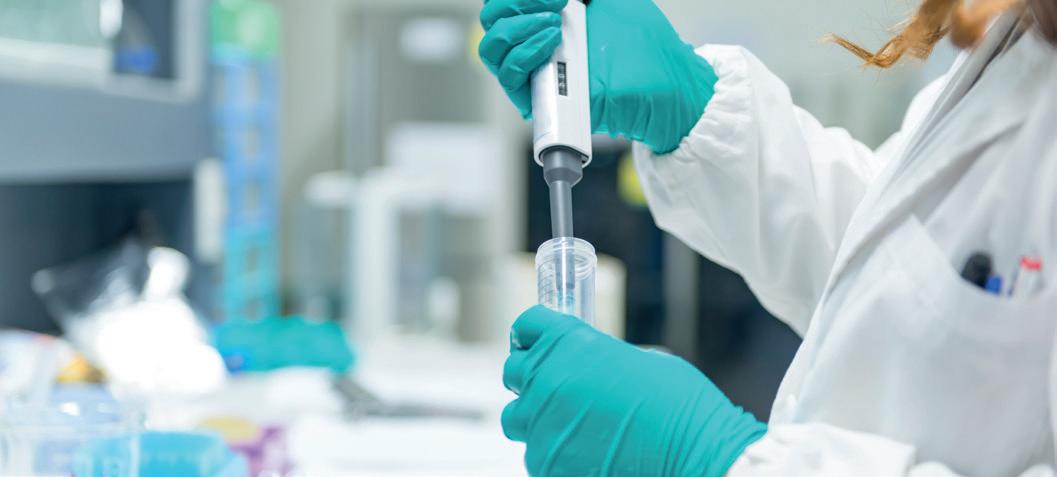
What safeguards are in place?
All samples go out with a VIVO Biobank identifier rather than any patient information and that ensures that the samples aren’t identifiable to the researchers. Information on those samples and the data on the patient, including sensitive data such as the patient's NHS number and their date of birth, is stored securely on a database at the University of York that’s only accessible to a few people at the biobank and through a secure password. We have strict protocols on how that data is stored, how it's accessed and how it's managed.
How can people be involved further with the VIVO biobank, other than by donating samples?
There are opportunities to join our patient and public involvement (PPI) group, and we’d love to hear from people that would like to take on more of an involvement if they find biobanking particularly interesting. The PPI groups are led by Dr Bethan Lloyd-Lewis, one of our co-investigators and a survivor of childhood cancer. She’s recruited 15 members, who are involved in all aspects of biobanking.
Members attend various committee meetings and are involved in helping put our application through ethics, and reviewing our patient information sheets and consent forms. They also come to our education events to talk about their experiences and why contributing to biobanking to try and help other young people with cancer in the future is important to them.
More information about our PPI group can be found on our website: www.vivobiobank.org
“I’m out of the shadows of trauma and into the light of living”
Teifi Rowley was diagnosed with cancer as a baby and again a few years later. They tell us about Anniben, a drag character they created that has helped them process the long-term impact of treatment through creativity and performance.
I was diagnosed with rhabdomyosarcoma when I was born, and then again when I was six, and was treated with chemotherapy and radiotherapy. After I first finished treatment, I didn't really think about my cancer much. It was just a part of my life. It was just what happened to me. But when I became a teenager, I started looking at myself a bit differently. I didn’t like my appearance because of how the therapies and all my different operations have made my body look.
I often find myself staring too long in the mirror. I see a pair of eyes, a nose, lips, ears, and one eyebrow. As time goes on, I notice more details about my face that feel like they shouldn’t be there. Missing or damaged teeth, a scar above my right eye, a flatter side of my face and a sunken eye socket. I have body dysmorphia. This is what I’ve come to understand.
For the longest time, I thought there was no way I could come to terms with my treatment and how it made me feel, but then I discovered drag. Through studying art at college, I developed an interest in makeup and character study. There, I came up with ‘Anniben’, a weird, clowny spirit that represented a part of me that I was always scared to accept: my body and being alive.
It had big blue eyeshadow, a long red nose and pale skin. Something about its sunken eye shape and poorly looking nose made me realise that I could find beauty through sickness, and one day decided to dress up as this character myself. Being able to change my face with makeup and having the decision to enhance or hide different parts of my
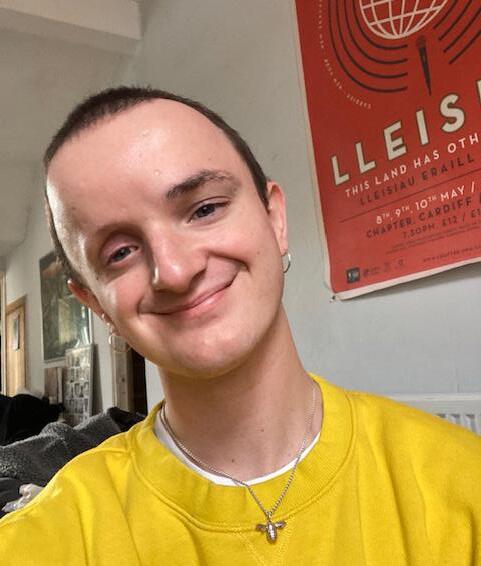
face and body was a gift. I finally had control. I could sometimes hide my scars, sometimes I could show them off.
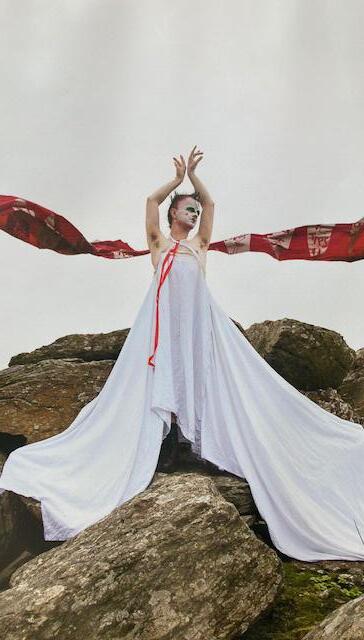
I’ve been performing as Anniben for three years now, and it’s so much fun. One night, I’d been performing when a friend said they’d been talking to someone who recognised my name. It was a nurse who cared for me as a child. We had a nice chat, and she told me what I was like on the ward, getting up in the middle of the night to play games in the nurses’ office. We started following each other on Instagram and she sent me a really nice message, which made me quite emotional.
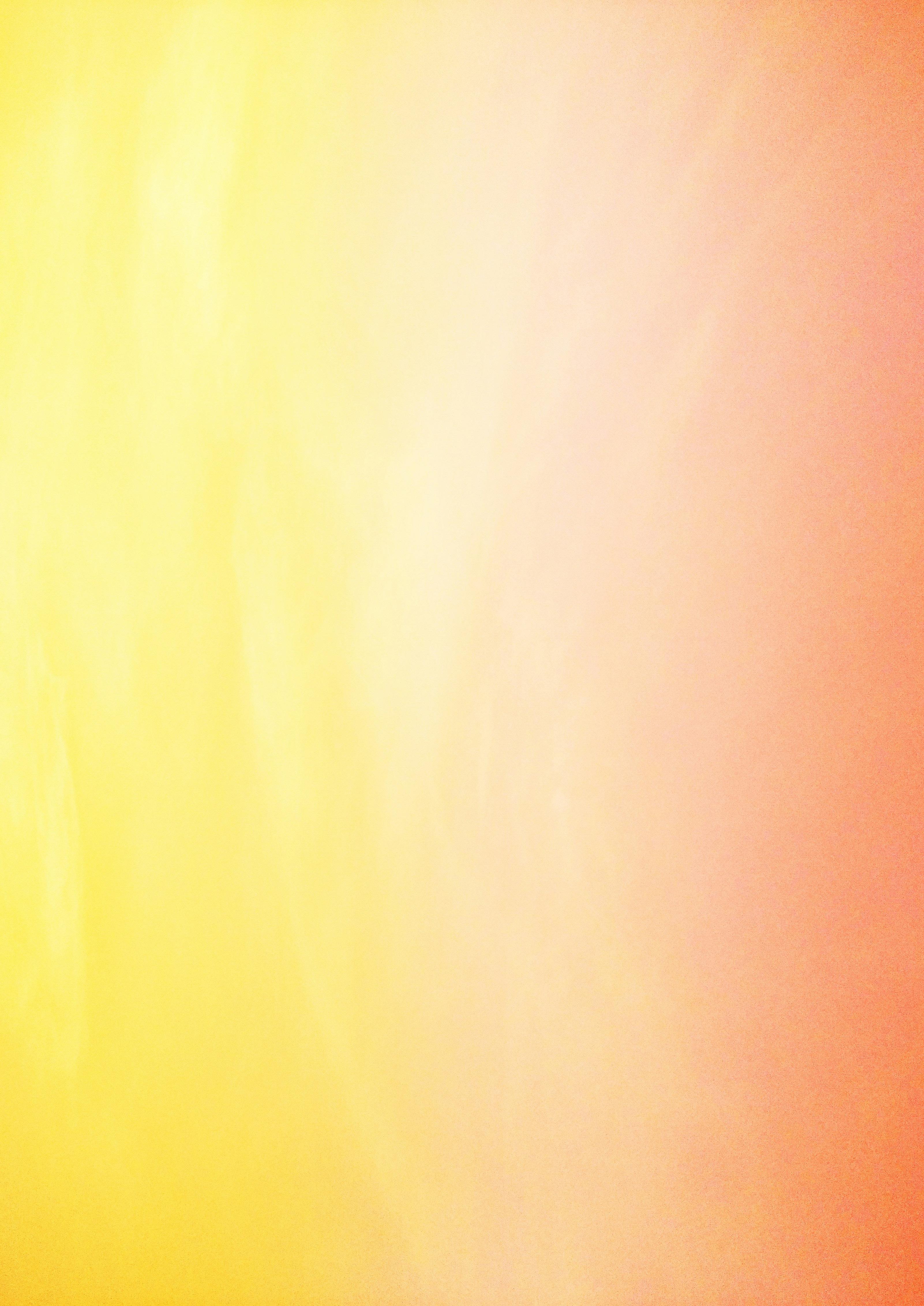
I was also recently discharged from my paediatric oncology clinic. Shortly after, I organised a show for me and my friends to put on, to commemorate stories in our lives. I told my story: about my cancer, my appearance, and what had held me back from coming to terms with everything. I even shaved my head on stage. It felt good, like I was claiming something back.
"I've come a long way and while there's still a way to go, it's not scary anymore. In fact, it's exciting!"
It’s only recently that I've really understood what I went through, and it's been a hard process coming to terms with it all. But Anniben has brought me out of the shadows of trauma and into the light of life and living. Yes, I still have trauma, but I feel much more comfortable living with it now, being able to incorporate my experiences with my art and performance so I can heal and express myself creatively. But more importantly, I’m happier with being in my own body. Now, when I sit down to do my makeup before a show, I don’t see my scars as imperfections anymore. Instead, I see possibilities to move forward, to create, to experience and, most importantly, to live.
I’ve come a long way and, while there’s still a way to go, it’s not scary anymore. In fact, it’s exciting!
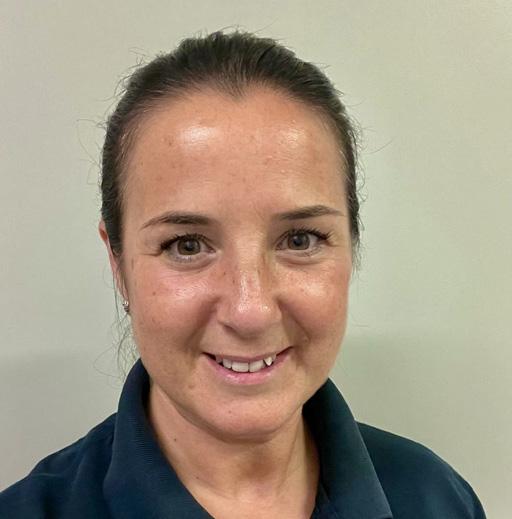
iCanMove: The physical activity pathway helping children and young people stay active during treatment
Louise Graham is a clinical specialist paediatric physiotherapist at The Great North Children’s Hospital. She tells us about how she created a physical activity pathway to help children and young people (CYP) with acute lymphoblastic leukaemia (ALL) stay active, and how she hopes to develop this to support all CYP with cancer.
Historically, the paediatric oncology physiotherapy service in our hospital was reactive, responding to and prioritising therapeutic need only. Despite emerging evidence showing the positive impact of physical activity on the longterm outcome of CYP with cancer, we had no capacity to implement this into our workload.
Research shows that physical activity levels are almost always reduced during treatment, and this can be seen for years after treatment ends. Moreover, exercise support and provision for CYP hasn’t been well integrated into healthcare and society, leading me to question whether we could change the way we work by implementing a pathway to keep them active, empower them, and support behaviour change from the day of diagnosis.
What did I do?
I submitted a charity application for funding to test this in the form of a quality improvement project called iCanMove, initially applying the pilot pathway to a group of children with ALL. Our research told us that in our hospital CYP and their families wanted support with three main things:
• Guidance on how to stay active during treatment
• Where to go in their local area with their friends and siblings
• How to continue their clubs and hobbies
From those three aims, I developed two vision statements for the project. The
first was from a clinical perspective, and the second from a patient perspective:
• For physical activity and exercise to become a mainstream of cancer treatment for all CYP diagnosed at The Great North Children's Hospital
• I want to still see my friends, have fun and stay strong
The new physical activity pathway was then developed and applied to all CYP with a new diagnosis of ALL. I’m currently working on collecting the retrospective data, but the anecdotal impact of the pathway so far has been incredible. I now work proactively with this group of CYP. They’re seen quicker and have active conversations from the day of diagnosis, where I’m able to educate and reassure them and their families about staying active safely and appropriately, adapting when required. They’ve reported feeling empowered and more knowledgeable about how, when and why they should stay active. Parents have said it’s something they can help their child with during treatment, giving them a little control back.
There’s been no rehabilitation admissions, referrals to local services or extra physiotherapy outpatient appointments needed for any CYP on the pathway. I’ve made many new contacts and partnerships with charities, local activity clubs and public health, which has provided more opportunities for the CYP in their local areas. Some of these contacts are now also coming in and working on the ward, clinic and day unit.
“Prior to my diagnosis I went to the gym every day. When I became unwell and was admitted to hospital, I soon had a portacath put in. I wasn’t sure how this would affect my ability to train but with support and guidance from Louise, I was able to go to the gym and know what I could and couldn’t do, helping me retain some of my strength. This meant I was still able to walk my dog instead of sitting in the house all the time and gave me a sense of normality.”
What’s next?
I’m now hoping to apply the pathway for CYP with other types of cancer, and I’ve recently submitted a funding application for the next phase which includes the recruitment of sport coaches to work with CYP in the hospital, as well as in a community outreach setting. I’m also co-chairing a CCLG physical activity and exercise subgroup, which has been created alongside other health and social care professionals. Our national vision is for physical activity and exercise support to be a standard part of supportive care for all CYP following a cancer diagnosis.
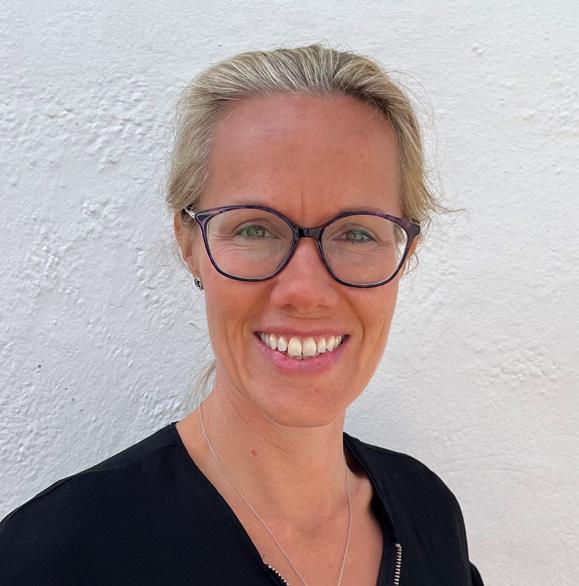
The importance of involving parents in shaping research and resources for families
Helen Pearson, Advanced Nurse Practitioner in solid tumours, researcher and CCLG member, undertook a study to understand parents’ decision making in relapsed and refractory neuroblastoma. She explains how the findings have helped co-design, with parents, an important new web resource to support families.
When a child’s diagnosed with neuroblastoma, there’s a treatment protocol which guides parents and healthcare professionals through what treatment to give and when. Unfortunately, if the disease returns, there’s no protocol to follow for relapsed neuroblastoma (cancer that has come back) and limited protocols for refractory neuroblastoma (cancer resistant to treatment) with no clear endpoints. Therefore, parents of children with relapsed or refractory neuroblastoma often have to make repeated decisions about treatment, which could include various options such as off-protocol treatments, clinical trials and experimental therapies.
Previous research into parent decision making in children’s cancer has not focused on how parents make decisions repeatedly in these circumstances. Over many years of working with families, I’d noted parents voicing the difficulties of decision making and embarked on the REDMAPP (Relapse/ Refractory Decision Making Parent Process) research study (www.redmappstudy.co.uk) to explore this decision making and find a better way to support parents in making these decisions.
Why do parents need support?
“It’s very difficult and it’s very tiring and it’s hard to know if you’re making the right decision. That’s the exhausting part of it because you want to make the decision that is right for your child.”
“Making treatment decisions for my child was a really difficult time for me and my husband. We felt so overwhelmed by the responsibility of trying to choose the right thing for him at the right time. The pressure as a parent is really immense because you feel like it’s all on you to make the right choices because ultimately this is a life and death scenario. It was really, really important to us to make sure we had explored every avenue and that caused a lot of pressure.”

What did the study look at?
The REDMAPP study first explored how parents made repeated treatment decisions when their child had relapsed or refractory neuroblastoma. Eighteen parents (12 mothers and six fathers) were interviewed, who were making treatment decisions for their child at the time. Parents had made between one to six treatment decisions during 2020-2022. The interview data was analysed and generated four themes:
• The importance of time in being with their child and exploring treatment options
• Uncertainty and its relationship with treatment risks, side effects and outcomes due to the poor prognosis of relapsed and refractory disease and no standard treatment protocol
• Parent adjustment of their cognitive and emotional needs as they made repeated decisions
• Parent involvement and responsibility within decision making The findings were illustrated so that they could be easily understood and shared on YouTube (search for REDMAPP Findings from Parent Interviews).

A parent involved in the study said: “Knowing as a parent how difficult it is to make these decisions when it comes to treatment for your child after they have relapsed, this really drove me to get involved in this study, because I want to make sure that parents who are in this awful position feel supported and, regardless of the outcome, feel like they have left no stone unturned and have really done everything within their power to help their child.”
How were the findings used?
These findings informed the development of a web-based support tool co-designed with parents. Parent involvement was so important to ensuring the content and design would meet parents’ needs. This was achieved through a combination of 10 face-to-face and virtual workshops over a period of 14 months. Parents first reviewed the study findings and translated these into topics the support tool needed to address. These included:
• providing practical resources to support parents in making decisions such as information on clinical trials, second opinions and support from charities
• acknowledging and validating the emotional impact of decision making with videos from other parents talking about their experiences, clinical psychologists speaking on strategies to support decision-making processes and psychological support to maintain parents’ mental wellbeing
• developing resources to facilitate conversations with healthcare professionals, such as a downloadable list of questions to help with discussing treatment options, a consultant speaking about their role and how they work within the wider team, and the importance of partnership working to empower parents in their decision making
• providing a glossary of terms to inform knowledge development. This informed the content for the tool which was continuously reviewed throughout the whole development process
We then researched options by reviewing the published literature on support tools such as apps or websites that had been developed in healthcare. The decision for a website was based on accessibility and cost-effectiveness. A web-design company chosen had experience of developing childhood cancer charity websites. The development process considered the website brand, user navigation, design and layout in mobile and desktop formats.
A parent involved in co-design of the website said: “It’s been an honour working with Helen and other parents to bring this website to life. It provides so much information that can help parents and I wish we had something like this available when we were making treatment decisions.”
Once the website was developed, it was user tested with parents who hadn’t been involved in the development process. The purpose was to review the website's accessibility, useability and
acceptability. One said: “The videos are great, a fantastic resource which allows information giving in a different way. This is going to help so many parents, it’s incredible.”
What’s on the website?
The website has many resources that can support parents, containing a vast amount of information informed by parent experiences to empower them in their decision making. From interviews with parents, it was gleaned that those who had made repeated treatment decisions often experienced a breakdown in their relationships with healthcare professionals, particularly when treatment options in the UK had decreased. The website addresses ‘working with your child’s healthcare team’, which contains suggestions on how to work in partnership when making decisions, and downloadable questions to support conversations.
There are also videos by Dr Ramya Ramanujachar talking about the National Neuroblastoma Advisory Group and how to ask for a second opinion, and Dr Guy Makin on the role of the consultant, and how they work within a wider team to discuss treatment options for individual children, and the importance of making decisions together with parents.
Having healthcare professionals involved with videos throughout the website empowers parents to ask questions and seek additional advice. This is important as research with bereaved parents has shown many experience regret in relation to treatment decisions made. Facilitating open and honest conversations, however difficult these may be, helps empower parents and their involvement in their decisions.
The website has a feedback function embedded to help keep content up to date and relevant to parent needs. Future research will evaluate the usefulness and effectiveness of the website in relation to parents who are making these decisions in real time.
I'd like to say thank you to the parents who co-designed this website: Mandy Berriman, Hannah Cohen, Karl Cox, Kate Dixon, Ian Talton and Samantha Wilkinson. www.redmapp.org.uk


Dr Claudia Heggie
Understanding experiences to improve access to light treatment for chemotherapy side effect
Dr Claudia Heggie is a paediatric dentist at the University of Leeds and Leeds Teaching Hospitals Trust. She’s been leading research looking at the use of photobiomodulation, a light treatment, to prevent a side effect of chemotherapy called mucositis, and how it can be best introduced in other children's cancer centres.
My research looks into preventing oral mucositis, the painful mouth ulcers that happen when receiving chemotherapy. We know this is a very common side effect of cancer and stem cell transplant treatments that’s extremely debilitating for children and young people, often making things like eating and talking difficult. We’re researching the use of a light treatment, called photobiomodulation, to help stop this from happening. The treatment works by shining a special red light on the cells inside the cheek and around the mouth. This light energy is absorbed into the cells and helps them to heal, reducing the ulcers caused by chemotherapy. It’s a very safe treatment and it can be used by children and young people of all ages, including babies. We hope this will improve quality of life during their cancer treatment.
What we did
We completed interviews with children and young people, their parents, and healthcare professionals to understand what having mucositis was like. We also asked them how they felt about the light treatment. We recorded and analysed interviews with the help of families in our research involvement group, and then worked with children and young people to co-create a video to explain what mucositis is like, and what to expect from the light treatment.
How this project will help
Despite mucositis being a very common side effect of chemotherapy, there’s been little research into the experiences of families and healthcare services who have used photobiomodulation. The light treatment is recommended in international guidance for managing mucositis, but it’s not widely used in the UK. Our previous research found this was partly because healthcare professionals didn’t know if children would have it done, or how acceptable it was. This project has shown that families and healthcare professionals are very enthusiastic about the treatment, and that children of a wide range of ages were happy to receive it. By sharing families’ thoughts and feelings about the treatment, cancer centres can use this information to support children when receiving it.
Finding out patients and families' thoughts
Families felt that mucositis removed them from their normality. Children told us that the light treatment would be like 'freedom' for them, allowing them to eat, sleep and communicate. One of our main findings was the importance of empowering families in light treatment service design. Children and young people liked that they could deliver it for themselves, choose which areas to have treated, and control where the treatment probes went.
Working together
This whole research project has been delivered alongside our Patient and Parent Involvement Group, supported by Candlelighters. Families have been involved from the beginning, telling us that mucositis prevention is an important area to research. A total of 17 families were involved, helping us to design the study, understand results, and co-create the video with children and young people who have used the treatment, and provide feedback on this. The cocreation process ensured that the video was child-focused and understandable. In addition, children and young people also helped create a video to explain their experiences of research involvement. They tell us that being involved in research makes them feel that their voice is heard, and their opinions are valued.
Developing light treatment services nationally
My PhD research focuses on how best to set up new light treatment services in different children’s cancer centres, to improve access to this treatment. Our video resources are used in other children’s cancer centres across the country to explain mucositis and the light treatment, and even to support the setting up of new light treatment services. They’re available at www.lchtv.com/photobiomodulation
A parent’s view...
Why raising funds and awareness is important to us
Nicky Levent’s son, Sam, was diagnosed with retinoblastoma when he was 18 months old. She explains what it means to her family to raise funds for charities and awareness of childhood cancer, and how it’s helped them.
Sam was diagnosed after we noticed a white glow in his eye in October 2014 and took him to our local GP. We were then referred to the local eye specialist at Royal Preston Hospital who told us the possibility that the glow in Sam’s eye could be retinoblastoma and arranged a referral to Birmingham Children’s Hospital.
On our way home from Preston we received a call from the specialist retinoblastoma team in Birmingham and we had an appointment for the following week. Following an examination under anaesthetic in mid-November, the consultant confirmed he had a large tumour in his right eye, before discussing the operation that Sam would have to undergo to remove his eye and the treatment that would follow.
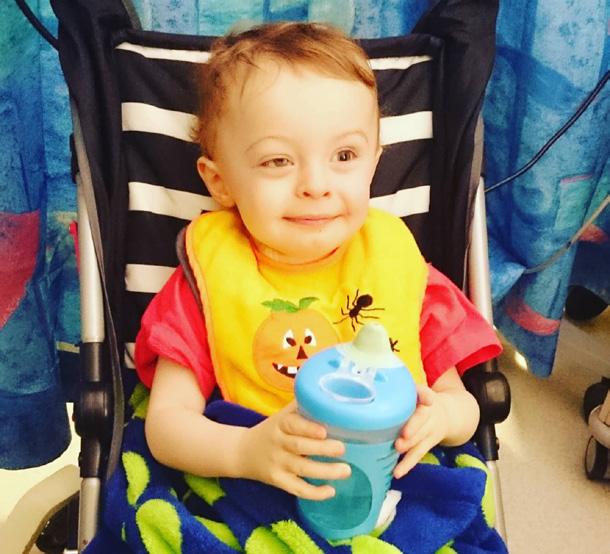
Sam had his eye removed three days later and we were in hospital for three days before he was discharged for home. We were told we had to wait for two weeks for the results of a scan to see if the cancer had spread anywhere and whether Sam required chemotherapy.
We were contacted two weeks later and told that as they weren’t sure whether it had spread or not, Sam would need four cycles of chemotherapy as a precaution. Our consultant in Manchester told us
Sam would have a Hickman line fitted first and a bone marrow and spinal fluid sample would need to be taken as well.
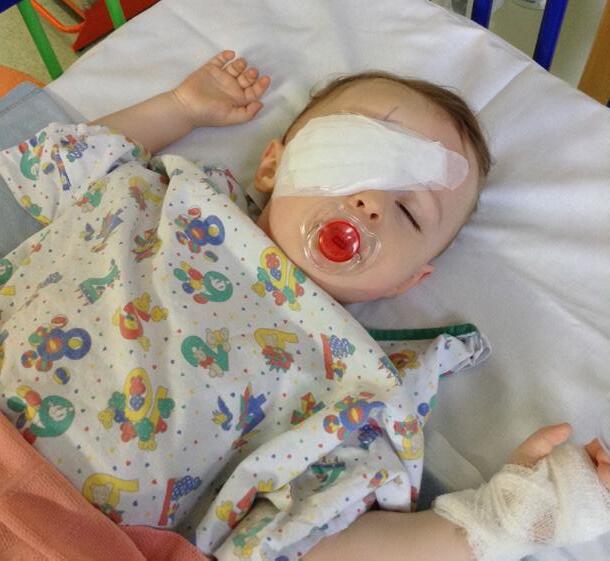
We spent the night of Sam’s first cycle of treatment in the hospital as they wanted to keep Sam under observation, and he was unwell that night. We had a few setbacks along the way due to his platelets being too low, and he needed a blood transfusion on his second visit. In between all his treatment sessions, we also had trips to Birmingham for his examination under anaesthetic and his appointments for his prosthetic eye.
My husband, Iskender, and close family were my rocks during Sam’s diagnosis and treatment. It helps to have a good support system. The nurses and doctors at Birmingham and Manchester were amazing and helped us so much. I also want to thank the charity CHECT for helping us with Sam, too. The one thing I’d say to parents during treatment is to keep busy, bring plenty of snacks and things to keep you all occupied, as it’s a long day at appointments and chemotherapy sessions.
Sam is now 11 and has been cancer-free for nine years, but he still has his regular prosthetic eye checkups. He has started his first year at high school and is obsessed with football.
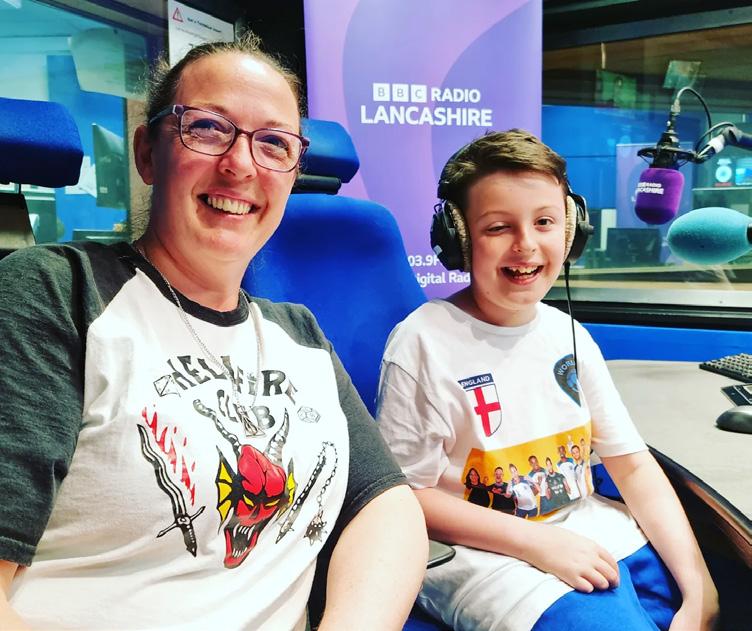
He has a great bunch of friends who have grown up with him and don’t see or treat him any differently.
Over the years, we as a family have done a lot of fundraising for cancer charities and, importantly, this has also given us a chance to raise awareness of retinoblastoma and childhood cancer. We regularly talk about Sam’s diagnosis, and this has been something that has helped him understand and accept what happened to him when he was younger. We regularly raise money for CHECT and other cancer charities. Back in 2017, my husband did a charity skydive, I did 'Brave the Shave' later the same year, we also do a birthday fundraiser every year, and we asked for donations at our wedding in 2018. Sam even held a ‘crazy glasses day’ at his nursery when he was younger. Raising money for charities and especially awareness of childhood cancer is important to us as highlighting it could save a lot of children. For families going through treatment, it can offer hope, and also helps to let parents (and children) know that they’re not alone, and support is out there.
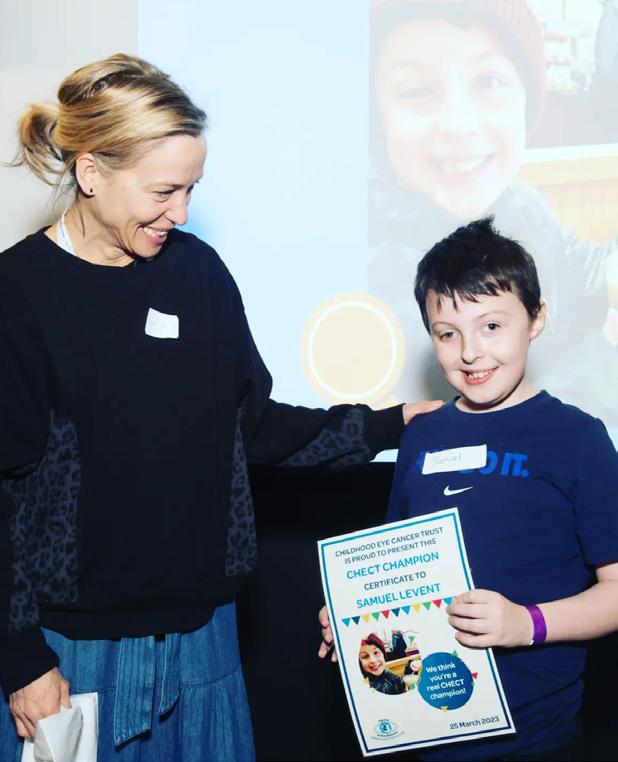
Knowledge is power: The awareness campaign aiming to accelerate diagnosis

Child Cancer Smart is a public health intervention aiming to empower both the public and healthcare professionals with knowledge about childhood cancer symptoms. Dr Shaarna Shanmugavadivel, CCLG Research Fellow at the University of Nottingham and part of the project team, tells us more.
Child Cancer Smart is a CCLG project with the University of Nottingham. It will be an evidence-based awareness campaign, providing guidance around when to see a doctor or when and how to investigate children and young people further, to accelerate diagnosis for all.
The idea for it came about after the success of the award-winning ‘HeadSmart’ campaign, which was set up to raise awareness around the signs and symptoms of brain tumours. The campaign was associated with halving the time taken to diagnose children with brain tumours across the UK. Earlier diagnosis means less brain injury at point of diagnosis and the potential for less intensive treatment and reduced morbidity and mortality.
Angela Polanco, mother of Bethany who sadly died after being diagnosed with a Wilms tumour, asked us why other cancers hadn’t been addressed, given the success of HeadSmart, and the journey to Child Cancer Smart began.
What’s been done?
To provide the campaign’s evidence, a series of research projects, funded by the National Institute for Health Research (NIHR) and CCLG, have taken place in recent years. The first was a large national observational study called the Childhood Cancer Diagnosis (CCD) study. It looked at children and young people diagnosed across the UK from 2020-2023, asking important questions about how long it took for them to be diagnosed and what route they took. Its data will allow us to understand the current picture of childhood diagnosis in the UK and what
factors might affect the intervals, enabling us to choose the priorities for focus in Child Cancer Smart.
We hope it will optimise referral pathways and speed up diagnosis and, ultimately, improve outcomes.
The second research project involved a series of systematic reviews (where all of the published scientific evidence is reviewed to see what good quality evidence is available on the topic) and Delphi consensus processes (where experts come together to agree recommendations in a structured way) to develop new tumour-specific clinical guidelines which will be translated into public- and healthcare professional-facing materials for Child Cancer Smart.
The third is the Childhood Illness Perception (ChIP) study. We ran focus groups with parents with and without childhood cancer experience, to understand the public’s perception of childhood cancer and how they seek healthcare information and advice, to see if there may be myths that need busting through the campaign messaging.
We're in the process of analysing and writing up the CCD study data and
aim to publish this by the end of the year. The ChIP study showed us that the public perceptions of cancer are different to reality. Parents of children with cancer told us that their concerns were dismissed and while they hadn’t thought of cancer, they also knew that the illness wasn’t following the usual patterns of short-lived illnesses they were used to.
What’s being developed and how it will it help?
For each guideline, the most important next step is developing the decision-support tool for each symptom. This tool has been well received by healthcare professionals as they help not only identify children and young people who need investigation, but also to safely reassure those who don’t.
We’re also developing the branding and messaging for the campaign, making sure that children and young people, as well as families, who have been affected by cancer have a chance to have their say and take part.
HeadSmart showed us that awareness is hugely powerful and can accelerate diagnosis. Providing easyto-follow, evidence-based advice will empower young people and parents to seek healthcare in a timely manner and, importantly, empower clinicians to reassure, review or refer their patients onwards.
Once the CCD data has been published, the first phase of Child Cancer Smart will launch. We hope it will optimise referral pathways and speed up diagnosis and, ultimately, improve outcomes.
Getting the ending right: feeling prepared to move into survivorship care when active treatment finishes
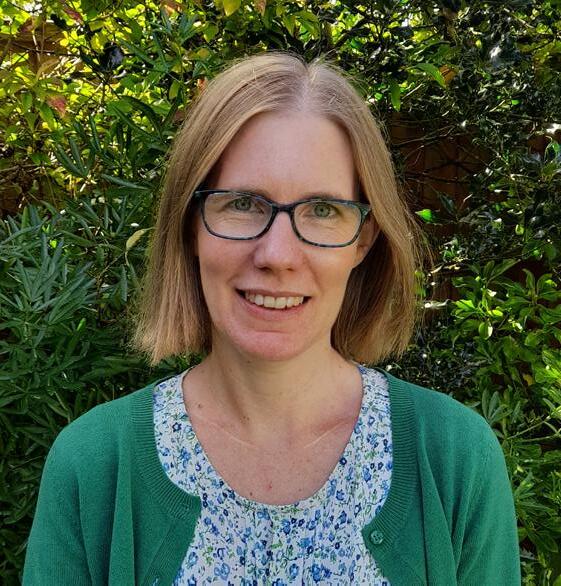

u LEAD INVESTIGATOR: Susie Aldiss, research fellow
u INSTITUTION: University of Surrey
u AWARD: £92,000 (funded by CCLG)
This project is looking at information sharing with children, young people and families at the end of active cancer treatment, as they move into survivorship care. The end of treatment can be a time of celebration for families, but it can also be a time of worry and uncertainty. Families must be given the right care, information and support which meets their needs. International research has shown that there are gaps in the information children and families get at the end of treatment. We don’t currently know whether children and families in the UK are receiving the information they need at this time. This topic was identified as important in the Children’s Cancer Priority Setting Partnership, which asked children, survivors, families and professionals which topics they would like future research to focus on.
What will we do?
This project will include families with a child aged 0-18 years old who has recently finished treatment in a principal treatment centre. We’ll ask families to fill in an end-of-treatment questionnaire, which asks about the different areas of information given, like late effects, support and follow-up plans. As well as a parent/carer questionnaire, there’s a questionnaire for children aged eight and above to fill in themselves. Children, young people and parents/carers will
have the choice to take part in an interview, to share their experiences in more detail.
We’ll also interview professionals who work with families at the end of treatment, asking them about what information is given to families, how it’s given, what resources are used and how much the child’s involved in these conversations.
What do we hope to find out?
Looking at what’s currently happening with information sharing at the end of treatment will help to identify what’s working well and where the gaps are, improving our understanding of what families need at this time.
We hope to find out:
• what types of information are shared and in what format?
• when are families given this information?
• who's giving the information?
• who’s involved in the conversations?
We also want to look at whether there are preferences for what’s shared, when, and how. For example, the end of active treatment is a significant event, and may not be the best time for families to talk about and take in information about follow-up care and what happens next.
What might this lead on to?
The end-of-treatment questionnaire we’re testing in this project could be used by hospital teams as an aid for improving communication of information to better meet the needs of families. We plan for this study to lead to further work, with the development of an intervention or resource to improve the sharing of information with children and families at the end of treatment.
How will this research empower children, young people and their families?
When a child finishes treatment, it’s vital that the family’s given information about the child’s cancer and treatment, possible late effects, and plans for follow-up. There are many late effects of cancer and treatment, which families need to know what to look out for and how to get help if they need it. Giving information to children means that as they get older, they can build on this information and start to take responsibility for their own health as they become an adult.
www.cclg.org.uk/our-
60 SECONDS WITH
Emily Baker
A clinical research nurse at Great Ormond Street Hospital (GOSH) and CCLG member
Q: Tell us a little about your career so far?
A: After qualifying, I spent 18 months on a general children’s surgery ward. However, my favourite placement as a student had been on a cancer ward, so I then came to Lion ward at GOSH and have been here ever since. I’ve been incredibly lucky to have had many roles, from working on the ward, being a clinical nurse specialist, covering as ward sister for a short time, and also working in education between the Trust and a university. For the last six years I’ve worked in the research team as a clinical research nurse, and currently I’m also working as part of the North Thames Children and Young People’s Cancer Operational Delivery Network.
Q: Tell us about your role in supporting young people with cancer and their families?
A: In my research role, I work as part of a wider research and innovation division within the hospital, but our team’s focus is on clinical trials within cancer. At GOSH, our cancer service offers clinical trials across all phases and for various timepoints of a patient’s disease. The research nursing team mostly works with patients eligible for an early phase trial (although we help out with elements of most trials).
We take patients from across the UK, so there can be a lot of coordination to support them coming to London to meet the team. When we meet the patient and their family, we’re responsible for helping them understand the trial being offered, which can mean follow-up calls, or sometimes follow-up visits, to ensure they have the chance to ask all their questions. As a nurse, alongside ensuring they know how the treatment
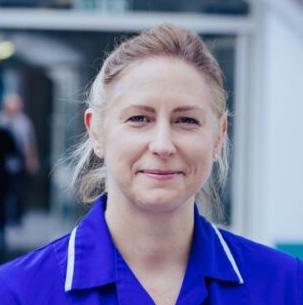
will be given, I want to ensure they know how often they need to come to us for a visit, and what investigations are required. Early phase trials are usually a bit stricter than standard care in terms of having visits at exact timepoints, so it’s important the families have all the information to empower them to make an informed decision that’s right for them and their situation.
When we meet the patient and their family, we’re responsible for helping them understand the trial being offered, which can mean followup calls, or sometimes follow-up visits, to ensure they have the chance to ask all their questions.
If the patient and family consent to the trial, we care for them from the time of consent, through treatment and into follow-up which includes delivering therapies, organising visits, taking samples such as blood or urine, and providing advice and support to them and their local care teams.
Research nurses are also involved in reviewing trials being set up, and we must ensure we can deliver what the trial requires – this might be planning how we can carry out the tests at the right times, or it might be ensuring there are policies in place to cover any new procedures. As a research nurse we also support the wider team with data collection and queries that may come through from the trial sponsors.
Q: What’s the most rewarding part of your job?
A: Some of the trials we offer allow patients to take medications at home, spend less time in hospital, and not experience some of the more common chemo side effects, which is hugely rewarding. I really value being part of a team which can offer innovative research studies across the spectrum. My job also challenges me on a regular basis. There’s always something to learn, or new situations to navigate. I feel very fortunate to do a job I enjoy, and that I hope makes a difference.
Q: Do you have any advice for families?
A: Have a notepad or your phone by your bed so you can write down any questions that pop up at night. Also, I think the most important thing to remember is there’s no right or wrong way deal with things, so don’t be afraid to share your emotions and feelings.
Naomi Shefford-Thomas, CCLG’s Health Information Officer
What is accessible information?
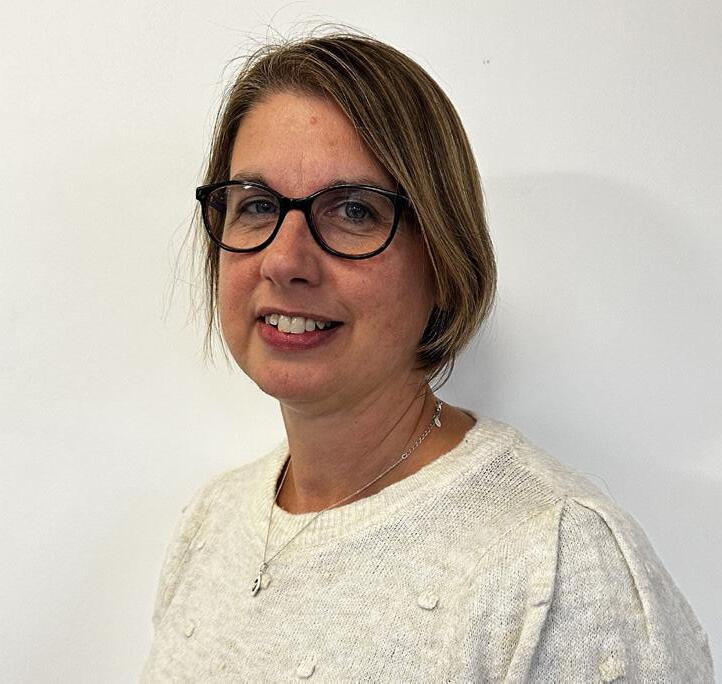
Accessible information is information created and provided in a way that is available to everyone, in whatever format meets their needs. When we’re in a stressed situation, our ability to read and take in information is limited and our literacy levels fall, so it’s particularly important that health information is accessible to all.
Why is it important?
Having accurate, reliable and easy-to-read information helps you to feel involved, to make informed decisions and get the support you and your child need.
But what if you prefer to read in your own nonEnglish language, you have a visual impairment, you struggle to read, or you have a cognitive disability?
Globally, one in seven people have a disability. For many, they experience barriers when they’re on the internet. For example, people with visual impairments might struggle if information is only available in text format. And those with cognitive disabilities might find it difficult to read information on a crowded web page. This can impact their ability to access online content or services.
What is CCLG doing to make our health information more accessible?
At CCLG, we want to ensure that everyone can access our information, from our professional members to the patients and families we support. To ensure our digital information is accessible for everyone, we have speech, reading and translation support on our website with the ReachDeck Toolbar.
The toolbar helps us to make our online content more accessible to everyone, giving extra support to people that might need it. The toolbar offers our visitors assistive features to give them a choice in how they access our online information.
Our visitors can choose to have our content read out loud. They can also remove distracting content, add a screen tint with a reading pane to help them focus or they can translate our web pages into over 100 languages, in addition to much more.
How does it work?
On CCLG’s website, www.cclg.org.uk click on the orange stickman icon in the bottom right-hand corner to launch the toolbar near the top of the webpage.
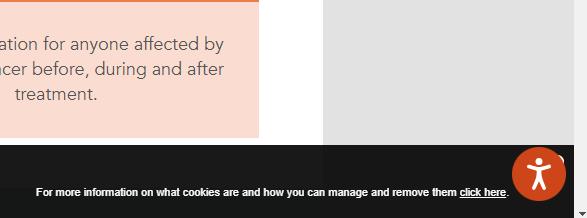

This toolbar will open at the top of the screen but can be moved around to suit. Click on each of the icons to find the right support tool you need, such as reading text aloud, translating into another language or simplifying the screen.
For example, to hear text read out loud, simply click on the ‘play’ icon and hover your mouse over any text. From a touchscreen device you’ll have to click on the text to hear it. Or, to apply a screen tint click on the eye icon.
To translate the page into another language, click on the ‘A’ box icon and choose your preferred language. Once translated, you can also listen to it read aloud in your chosen language.
To explore more, click on the question mark (?) icon to discover what each feature on the toolbar does. To use the tools with our publications, make sure that the toolbar is open on the website before you download them.
Virtual gifts from CCLG are expressions of love, support and hope. Each gift is a donation that directly contributes to our mission of changing the future for children with cancer.
GIVE THE GIFT OF SUPPORT for £10 to help us provide expert, reliable information and advice to families facing a childhood cancer diagnosis
GIVE THE GIFT OF HOPE for £20 to support an hour of vital childhood cancer research
GIVE THE GIFT OF TIME for £50 and help support our early diagnosis work
HOW IT WORKS
Choose from our collection of virtual gifts, each designed to make a meaningful impact
We'll send you an A5 greeting card of your choice and a gift certificate explaining the gift you have purchased
Add a personalised message to the card and the recipient's details to the gift certificate, and send it on to them.
